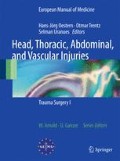Abstract
The modern concept of diagnostic laparoscopy for trauma patients emerged in the early 1970s. The literature shows that a variety of laparoscopic techniques are applicable to patients with abdominal trauma. Treatment of abdominal trauma requires a precise diagnosis that is not always possible with imaging techniques. As the danger is particularly great that an injury to the diaphragm or intestines might be overlooked, exploratory laparotomy can be warranted; however, up to 41% of exploratory laparotomies are nontherapeutic and could have been avoided with laparoscopy.
The ultimate value of laparoscopy for diagnosis and treatment depends on identifying the benefits and risks. The main benefit of laparoscopy for trauma is reduction of the rate of nontherapeutic, negative laparotomies with a subsequent decrease in hospitalization. The major risk of applying laparoscopy to the care of trauma patients is the potential delay in definitive treatment. Laparoscopy also entails a potential risk of missed injuries and, of course, procedure-related complications.
The basic prerequisite for laparoscopy in trauma is the stability of the injured patient. The current approach to abdominal trauma is the judicious use of laparoscopy to determine the need for further surgery. In blunt trauma, laparoscopy may have a role as an adjunct to computed tomography (CT) in nonoperative management of solid organ injuries. In these cases, laparoscopy can be helpful in evaluating the injury, detecting occult lesions, and selecting patients for nonoperative treatment.
In penetrating trauma, laparoscopy appears to offer greater scope. It can be of importance in the evaluation of peritoneal penetration. The difficulty in evaluating peritoneal penetration in lower chest stab wounds and the efficacy of laparoscopy have both been documented in the literature. In patients with entry and exit gunshot wounds, but without diffuse peritoneal signs or hemodynamic instability, laparoscopy can also establish the diagnosis of peritoneal penetration.
Besides its role as a diagnostic tool, laparoscopy offers exciting therapeutic potential. Small gunshot wounds of the diaphragm can be sutured, stapled, or covered with prosthetic mesh laparoscopically. Further potential applications for laparoscopy in trauma involve the closure of gastrointestinal perforations and achieve hemostasis of low grade liver and splenic lacerations using adhesives.
In summary, minimally invasive surgery has already established itself as a useful tool in the management of trauma patients. Laparoscopy can be performed safely and effectively in stable patients with abdominal trauma. The most important advantages are reduction of morbidity, shorter duration of hospital stay, and cost effectiveness. In the future, new developments in laparoscopy equipment and the introduction of computer technology and robotic devices can be expected to have a decisive influence on the treatment of trauma patients.
Access this chapter
Tax calculation will be finalised at checkout
Purchases are for personal use only
References
Ballard RB, Rozycki GS, Newman PG et al (1999) An algorithm to reduce the incidence of false-negative FAST examinations in patients at high risk for occult injury. J Am Coll Surg 189:145–151
Carnevale N, Baron N, Delany HM (1977) Peritoneoscopy as an aid in the diagnosis of abdominal trauma: a preliminary report. J Trauma 17:634–641
Chol YB, Lim KS (2003) Therapeutic laparoscopy for abdominal trauma. Surg Endosc 17:421–427
Gazzaniga AB, Stanton WW, Bartlett RH (1976) Laparoscopy in the diagnosis of blunt and penetrating injuries to the abdomen. Am J Surg 131:315–318
Heselson J (1970) Peritoneoscopy in abdominal trauma. S Afr J Surg 8:53–61
Ivatury RR, Simon RJ, Siahl WM (1993) A critical evaluation of laparoscopy in penetrating abdominal trauma. J Trauma 34:822–828
Killeen KL, Shanmunagathan K, Poletti PA et al (2001) Helical computed tomography of bowel and mesenteric injuries. J Trauma 51:26–36
Livingstone DH, Tortella BJ, Blackwood J et al (1992) The role of laparoscopy in abdominal trauma. J Trauma 33(3):471–475
Mihos P, Potaris K, Gakidis J et al (2003) Traumatic rupture of the diaphragm: Experience with 65 patients. Injury 34:169–172
Rozycki GS, Ballard RB, Feliciano DV et al (1998) Surgeon-performed ultrasound for the assessment of truncal injuries: lessons learned from 1540 patients. Ann Surg 228:557–567
Shanmunagathan K, Mirvis SE, Chiu WC et al (2004) Penetrating torso trauma: triple contrast helical CT in peritoneal violation and organ injury – a prospective study in 200 patients. Radiology 231:775–784
Smith RS, Fry WR, Morabito DJ et al (1995) Therapeutic laparoscopy in trauma. Am J Surg 170:632–636
Uranüs S, Pfeifer J (2001) Nonoperative treatment of blunt splenic injury. World J Surg 5:1405–1407
Villavicencio RT, Aucar JA (1999) Analysis of laparoscopy in trauma. J Am Coll Surg 189:11–20
Author information
Authors and Affiliations
Corresponding author
Editor information
Editors and Affiliations
Rights and permissions
Copyright information
© 2011 Springer Berlin Heidelberg
About this chapter
Cite this chapter
Uranues, S., Fingerhut, A., Bergamaschi, R. (2011). Laparoscopic Procedures in Trauma Care. In: Oestern, HJ., Trentz, O., Uranues, S. (eds) Head, Thoracic, Abdominal, and Vascular Injuries. European Manual of Medicine. Springer, Berlin, Heidelberg. https://doi.org/10.1007/978-3-540-88122-3_13
Download citation
DOI: https://doi.org/10.1007/978-3-540-88122-3_13
Published:
Publisher Name: Springer, Berlin, Heidelberg
Print ISBN: 978-3-540-88121-6
Online ISBN: 978-3-540-88122-3
eBook Packages: MedicineMedicine (R0)

